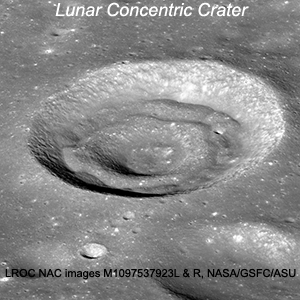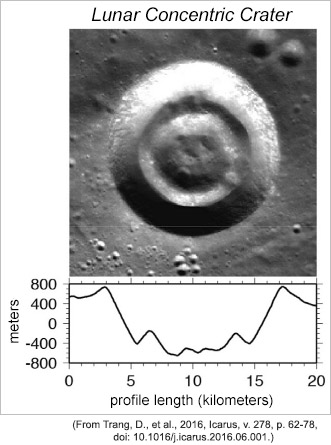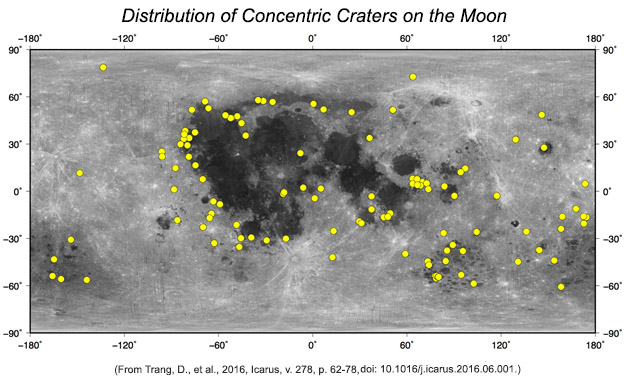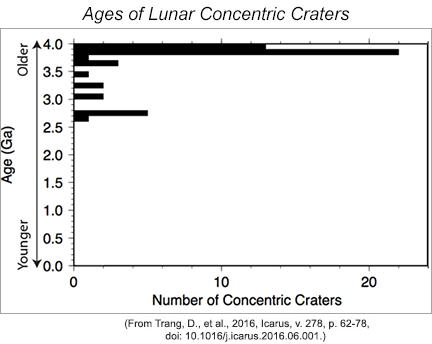Citation: Trang, D. (August, 2016) What Made the Doughnuts Inside Lunar Concentric Craters? PSRD, http://www.psrd.hawaii.edu/Aug16/Lunar-concentric-craters.html.
 |
August 30, 2016
What Made the Doughnuts Inside Lunar Concentric Craters?
--- Concentric ridges inside small lunar craters may have formed when intrusion of magma caused uplift of the crater floor.
Written by David Trang
Hawai'i Institute of Geophysics and Planetology
Nearly all lunar impact craters smaller than 15 kilometers in diameter come in one basic shape, a circular bowl with a rim around it. However, there is a category, called concentric craters, with the basic crater and rim, plus a doughnut-shaped feature within the crater that is concentric to the crater rim. Jeffrey Gillis-Davis (University of Hawai‘i), the late B. Ray Hawke, and I (still at the University of Hawai‘i) decided to take on the task of determining how these concentric craters formed. After long meticulous measurements of their shape, determining their composition, examining their spatial relationship on the lunar surface, and calculating their age, we find that these craters are regular impact craters that experienced intrusions of magma beneath them. Each intrusion pushed on the material around the crater causing the construction of the concentric doughnut-shaped topographic ridge.
Reference:
- Trang D., Gillis-Davis J. J., and Hawke B. R. (2016) The Origin of Lunar Concentric Craters, Icarus, v. 278, p. 62-78, doi: 10.1016/j.icarus.2016.06.001. [ abstract ]
- PSRDpresents: Lunar Concentric Craters --Short Slide Summary (with accompanying notes).
An Anomalous Crater
The shape of impact craters less than 15 km in diameter is well understood; these small craters have a basic bowl shape and a rim. In the first year of my graduate studies, I toured through the lunar surface using visible images from the Clementine spacecraft to become familiar with the geography and landscape. One set of craters that had me tilting my head every time was the concentric craters. These craters have the basic crater and rim, but they also have a beautiful and perfectly sculpted concentric doughnut-shaped ridge within the crater (called the concentric ridge), which makes these craters conspicuous and odd-looking. I scoured through the literature with the help of B. Ray and to my surprise the studies of these craters were sparse. The most detailed study came from Charles A. Wood in 1978 in a conference abstract that was about 30 years old at the time we started this investigation. Several of the literature sources did provide suggestions to how these doughnut-shaped concentric ridges formed, such as near-simultaneous, successive impacts into the same point on the surface, volcanism, and mass wasting (i.e., landslides). But a consensus for their formation was nowhere to be found. It was then that I decided to make a full, in-depth study of these concentric craters.

|
Lunar crater Hesiodus A (at 17.1oW, 30.1oS) has a diameter of 15 km. Its concentric ridge is visible in this LROC wide angle camera (WAC) image and in the horizontal profile determined with Lunar Orbiter Laser Altimeter (LOLA) data. Profile's vertical exaggeration is 4x. |
Defining the Properties of Concentric Craters
The first task was to determine how many concentric craters are present on the lunar surface. My search through the global maps —obtained by the Lunar Reconnaissance Orbiter Camera (LROC) Wide Angle Camera (WAC)— with the help of B. Ray and Jeff found a total of 114 concentric craters. Their locations, plotted on the map below, reveal a major pattern—concentric craters mostly occur on the border between the highlands and the maria. In fact, 80% of concentric craters are less than 60 kilometers from a mare boundary.

|
| Yellow dots indicate the locations of concentric craters mapped by Trang and colleagues. They found that 80% of concentric craters are near margins of the maria. Background map is a normal albedo map of the Moon (see PSRD CosmoSpark report: An Improved Calibration of Reflectance Data from LOLA). |
Next, we decided to measure the shape of each concentric crater with the help of a Hawai‘i Space Grant undergraduate fellow, Elyse Iseke. We certainly did not know what we would find or what we would learn from this time consuming task. Nonetheless, I thought it would be worth a shot with the hope that we would discover something that would give a solid hint to their origin. Using the LROC WAC images and the topographic data based on the Lunar Orbiter Laser Altimeter (LOLA), we measured crater diameter and depth, the width and height of the rim, and the height and diameter of the concentric ridge. These measurements were compared to several other crater types (see images below), such as fresh craters (craters ≤1 billion years old), degraded craters (craters >1 billion years old), and floor-fractured craters (craters that have been modified by magma intruding into fractures in the rock underneath the crater) in order to understand how the shape of concentric craters deviated from normal changes in crater shape with time. The results showed that concentric craters had unusually shallow depths. The question at this point was, where did the extra material come from to make the craters so shallow?

|
| LROC WAC images of craters that Trang and colleagues used to compare with the concentraic craters: fresh crater (≤1 billion years old), degraded crater (>1 billion years old), and floor-fractured crater (a crater modified by magma intruding into fractures in the rock underneath the crater). |
The next task was to measure the composition of concentric craters. From visible images, we did not expect to see any compositional differences between the crater interiors and the surrounding areas. After using iron and titanium maps based on the algorithms from Paul Lucey and colleagues on Clementine ultraviolet-visible-wavelength data (see for examples PSRD articles: Moonbeams and Elements and Composition of the Moon's Crust), this was certainly the case; there were no compositional differences between the crater interior and the surrounding area.
The final task was to determine the ages of concentric craters. We determined ages by using a method by Pohn and Offield from 1970 that estimates the relative age of a crater based on its degradation compared to fresh craters. Previously, my colleagues and I calibrated their system to estimate an absolute model age, which determines a crater's age within an error of 1 billion years. Although that is a big error, the majority of concentric craters are predicted to be >3 billion years old, but no younger than 2.5 billion years old. So even with the errors, we think these concentric craters are very old and none is younger than 1 billion years old.

|
| The majority of lunar concentric craters are more than 3.5 billion years old. |
Formation Scenarios: Impact, Surface, or Subsurface?
The concentric ridge could be a product of impact processes, related to properties of the impactor (e.g., composition, porosity, etc.), properties of the surface (e.g., composition, layering of different rock types, presence of water, etc.), or the dynamics of the impact (e.g., near-simultaneous impacts). After considering several impact origins for the concentric ridge, we concluded that no impact processes could account for the consistent, old age of concentric craters, which are no younger than 2.5 billion years old. Craters <15 km in diameter, the size range of concentric craters, continue to form throughout the geologic history of the Moon. Therefore, we would expect to see concentric craters that are less than a billion years old, which is not the case. Additionally, impact craters occur randomly throughout the surface with a slight preference towards the equator, but again this is not observed for concentric craters. On the contrary, concentric craters have a preference for mare margins.
If the concentric ridge is not a product of impact processes, then perhaps it formed due to surface processes, such as mass wasting or lava flows on the floor of the crater. Because concentric craters are unusually shallow, the extra material may have come from material from the crater walls sliding into the crater, but concentric craters do not share the same shape as degraded craters and they are significantly shallower craters. Also there would be no reason for mass wasting to only occur on craters near mare margins. A volcanic process could cause anomalous shallowing of a crater by the extrusion of lava from the crater floor to flood the interior. But in examining the composition of concentric craters, we do not observe any compositional differences between the interior and the surrounding area, as would be expected for lavas of mare basalt composition.
The last potential process is the same process that formed floor-fractured craters: the uplift of the crater floor due to subsurface, intruding magma. This process coincides with our observations for several reasons: the anomalous shallow floors of concentric craters match the anomalous shallow floors of floor-fractured craters. The age of concentric craters tells us they formed when the Moon was most volcanically active and are located in regions where floor-fractured craters exist, which are near volcanically active regions. Finally, magmatic intrusions underneath a crater would not change the composition of the crater floor. Thus, concentric craters probably formed similarly to floor-fractured craters. On the other hand, this adds a new mystery: if floor-fractured craters and concentric craters share a common formation process, why do they look nothing like one another? Why does the same process form two different-looking craters?

|
| Cartoon showing three important stages in the formation of lunar concentric craters. (a) An impact produces a bowl-shaped crater and fractures the subsurface. (b) Magma preferentially moves into the fractures. (c) Magma resides and expands in the fractures causing uplift of the crater floor and the formation of a concentric ridge. |
Relationship to Crater Size
To answer the question of why the same process forms two different craters, we return to crater size. Floor-fractured craters tend to form in pre-existing craters with diameters >10 km. In contrast, concentric craters form in pre-existing craters with diameters <15 km. The only common size range for floor-fractured craters and concentric craters is the 10–15 km diameter range.
This range is close to the range of the simple to complex crater transition, where impact craters <15 km are bowl shaped, but craters >15 km exhibit a bowl shape with a central peak in the middle of the floor (see images below). What this implies is that magmatic intrusions underneath small craters likely form concentric craters and intrusions underneath big craters likely form floor-fractured craters and the difference is probably related to this simple-to-complex crater transition.

|
| [LEFT] Euclides (29.6oW, 7.4oS) is an example of a simple, bowl-shaped crater. [RIGHT] Lansberg (26.6oW, 0.3oS) is an example of a complex crater, showing a central peak in the crater floor and terraced walls. Note the difference in the sizes of these craters. The transition from simple to complex occurs at ~15 km rim diameter. |
But how do concentric craters form a perfectly-sculpted doughnut-shaped concentric ridge? What are the characteristics of the subsurface fractures underneath simple and complex craters that would encourage a crater to become a concentric versus a floor-fractured crater after the intrusions of magma? How does the magma fill these fractures underneath the craters? Is there a remote method to indirectly show that magma is responsible for forming concentric craters? Some questions will be left to a future computer or laboratory model. I hope that this time they will be answered less than 30 years from now.
- PSRDpresents: Lunar Concentric Craters --Short Slide Summary (with accompanying notes).
- Martel, L. M. V. (May 2016) An Improved Calibration of Reflectance Data from LOLA, Planetary Science Research Discoveries, http://www.psrd.hawaii.edu/CosmoSparks/May16/LRO-reflectance.html.
- Martel, L. M. V. (Dec 2004) Composition of the Moon's Crust, Planetary Science Research Discoveries, http://www.psrd.hawaii.edu/Dec04/LunarCrust.html.
- Pohn, H. A. and Offield, T. W. (1970) Lunar crater morphology and relative age determination of lunar geologic units - Part 1, Classification, U.S. Geol. Survey Prof. Paper, 700-C, C153-C162.
- Taylor, G. J. (Oct 1997) Moonbeams and Elements, Planetary Science Research Discoveries, http://www.psrd.hawaii.edu/Oct97/MoonFeO.html.
- Trang D., Gillis-Davis J. J., and Hawke B. R. (2016) The Origin of Lunar Concentric Craters, Icarus, v. 278, p. 62-78, doi: 10.1016/j.icarus.2016.06.001. [ abstract ]
- Trang D., Gillis-Davis, J. J., and Boyce, J. M. (2015) Absolute Model Ages from Lunar Crater Morphology, Journal of Geophysical Research: Planets, v. 120(4), p. 725-738, doi: 10.1002/2014JE004639. [ abstract ]
- Wood, C. A. (1978) Lunar Concentric Craters, Lunar and Planetary Science Conference IX, p. 1264-1266. [ abstract ]
|
|
[ About PSRD | Archive | CosmoSparks | Search | Subscribe ] [ Glossary | General Resources | Comments | Top of page ] |
